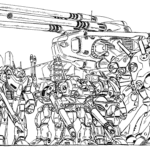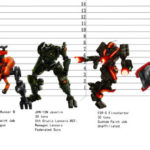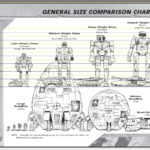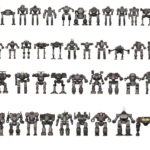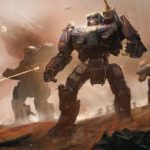Modern forces deploy across Space, and that means so do their APCs and other armored vehicles. To make this easier, tanks, for example, now stand tall and come standard with robotic legs doubling as landing shocks. Colloquially, these walking war machines are called BattleMechs. They make up a significant portion of the Space-faring mechanized infantry.
–
Table of Contents:
- Introduction
- Chassis Types
- Classifications
- Variants
- Further Details
- Images
–
Introduction:
A BattleMech (often abbreviated ‘Mech, although that could technically also refer to Industrial Mechs) is an armored combat vehicle of roughly humanoid shape, standing 8 to 14 meters (~26-50′) tall and typically massing from 20 to 100 tons. ‘Mechs are best suited for ground combat, although they are also capable of operations underwater, in hazardous environments, and in Space.
In general, BattleMechs are considered superior to conventional combat vehicles, being faster, better armed, and better protected, creating a firepower-to-manpower ratio which also gives them a logistical advantage. ‘Mechs replicate many of the movements humans are capable of performing, including acrobatic feats such as shoulder rolls, which allow them to avoid, deflect, or otherwise lessen the impact of weapons fire. Their downside is the incredible expense associated with producing and maintaining ‘Mechs; even the cheapest ‘Mech can cost millions of C-Bills –ensuring cheaper combat vehicles a continued role in warfare. Still, the best way to fight a ‘Mech is with another ‘Mech, preferably one larger and more powerful; duels between evenly-matched ‘Mechs have been known to last for hours.
Why not just save all that money and keep fielding regular vehicles?
- There are colonies/worlds which don’t have terrain that can easily (or at all) be driven upon; some places are just too rugged/cratered for wheeled or tracked vehicles to make sense.
- There are also plenty of times when climbing, jumping, or boosting (rockets, etc.) over cliffs and other steep obstacles can turn the tide of a battle, even a war; it is always preferable to not have to wait for air-transport.
- ‘Mechs are almost always taller than other land vehicles, thus they have better visibility, and ‘command the high ground’ –even when not upon the highest spot of the terrain/area.
- They typically have a wider array of weapons.
- Their armor lasts longer, and can be melted off in layers; even under heavy laser fire, a single damage/impact usually won’t/can’t mobility-kill or catastrophically-kill them.
- Few other fighting vehicles can transition so easily from water to land and back –and when they want to be stealthy in some waterways, they can crouch, crawl, or lie down, staying fully submerged until it is time to rise back into action.
- Forests and swamps won’t stop these things, not at all.
- Non-BattleMechs (nearly all other vehicles) typically aren’t -standard- linked to constant data/intel from orbit/fleet/s and other sources; they offer far less ‘clearing of the fog of war’ to their drivers/operators/crew.
- ~Infinite energy/fuel and firepower/ammo.; reactor-based, at least for propulsion and lasers. Most other vehicles do not have their own reactors.
- While you can fairly-easily immobilize/destroy other/lesser vehicles, such as by damaging/destroying one of their track-links or wheels, among many other critical parts, immobilizing a BattleMech requires getting through nearly-magical super-armor around joints as big as the entirety of most other vehicles –and even then… there is still a good chance the ‘Mech pilot/s can keep firing and limping or crawling toward their targets, if not leaping/rocketing along, anyway.
- A ‘Mech can use its hands (if it has hands) to do a lot of the work otherwise left to cranes and recovery vehicles (super tow-trucks). It might dent parts of the exterior of whatever it is picking up, but it also will probably save that vehicle and the lives of everyone around who might otherwise be waiting a very long time for a recovery vehicle or dropship.
- Skyscraper on fire? People trapped in its upper floors? Just walk a ‘Mech over so they can walk out onto its upturned palms and be precision-lowered to street-level.
- Skyscraper taking damage or requesting protection before damage is likely to occur? Stand your ‘Mech in front of it. You can’t do that with other vehicles.
- Other vehicles need big parachutes to safely land if dropped from aircraft or spacecraft.
- Seeing/Witnessing a modern mechanized Titan, essentially (the robotic equivalent of the super-giants in ancient legends), has a profound psychological effect –both on allies and enemies.
- Speaking of giants, no vehicle is better at handling the hostile ones than these. Some giants can throw a spear through multiple armored men at once, kick down a grown tree, or even barehanded tear normal vehicles to pieces, but they can do little against BattleMechs. Have a world with very large wildlife? You can now subdue it all with relative ease, thanks to BattleMechs.
- When a big battle leaves a vast field of wreckage and rubble, you don’t need to slowly tow away piece after piece before making your way through; ‘Mechs can step over most of it, and push or kick the rest out of the way –for themselves and convoys that might be following them.
- Think of BattleMechs as the Special Forces/Ops/Warfare of tanks/vehicles.
–
Chassis Types
Bipedal: Covering the vast majority of the types of BattleMechs, bipedal ‘Mechs come in three types:
Humanoid-type BattleMechs with knee-joint legs are the most commonly encountered BattleMechs; iconic ‘Mechs of this kind include the Wasp, Phoenix Hawk, Warhammer, Atlas and Summoner (Thor).
Reverse joint (chicken-walker) bipedal ‘Mechs are slightly less common on the field of battle, but include such famous ‘Mechs as the Locust, Catapult, Marauder, and Timber Wolf (Mad Cat).
Digitigrade bipedal mechs that have hip, knee, ankle, and toe joints and walk on their toes are the rarest of the three. Examples include the Thanatos, Nova Cat, and Mongoose.
Tripodal: ‘Mechs normally have two or four legs. The only three-legged ‘Mechs known are the exotic Colossal class Ares and Superheavy Poseidon ‘Mechs which appeared in the early 3130s, and the heavy-class Triskelion BattleMech which appeared in the 3140s. The Hedgehog was previously mentioned as a tripodal ‘Mech from the Star League era, having allegedly been introduced in 2602, but it is not considered canonical.
Quadrupedal: The Quad ‘Mech uses its “arms” for legs which gives these designs some additional stability and maneuverability (such as sidestepping, also known as lateral shift movement). The concept was much maligned for sacrificing the overall versatility of BattleMechs and the early designs, notably the Scorpion and the Goliath, proved flawed, being notoriously difficult to maintain and highly susceptible to breakdowns. It was only around the year 3060 that improved technology led to new quadrupedal ‘Mech designs, although the stigma associated with the general concept still lingers. Bipedal BattleMechs remain the vastly more common ‘Mech.
Land-Air ‘Mech (LAM): A special, and very rare, type of BattleMechs based on common designs, the Land-Air ‘Mechs (aka LAM) can transform from a regular BattleMech form into an Aerospace Fighter, or an intermediate form referred to as LAM Mode. While performing just like a conventional BattleMech or Aerospace Fighter in the respective form (to the point of being kept in either ‘Mech bays or fighter hangars aboard DropShips), in LAM Mode these ‘Mechs can quickly traverse great distances, giving them a tactical advantage in ground combat although their real niche apparently is reconnaissance. However, their delicate technology is unduly susceptible to damage and the combat performance of Land-Air ‘Mechs fell short of expectations by a long margin, especially considering their exorbitant production and maintenance costs. Land-Air ‘Mechs were only produced in small numbers and the ability to maintain and repair (or even produce) them was largely lost early on in the succession wars. The concept quickly faded into obscurity from a combination of small numbers, maintenance shortfalls and combat attrition.
The Clans abhor the concept, as it dilutes their strict distinction between ‘Mechs and aerospace forces. Clan Nova Cat famously took great care to raze the last remaining LAM factory to the ground during the Clan Invasion. Only Clan Jade Falcon is known to have delved into LAM research, but the project was terminated in 3059 after only two prototypes (Evil Twin One and Evil Twin Two) had been built; the scientists found the Land-Air Mechs to be too unstable to field in normal combat.
QuadVee: A variation of the LAM type BattleMech. The QuadVee is a hybrid of the Quadrupedal style BattleMech and the Combat Vehicle which has conversion equipment to switch between two modes. The QuadVee was developed by the Clan Hell’s Horses during the later part of the Dark Age Era. It’s creation was a means for the Clan to bolster it’s Touman. The QuadVee requires a two man crew (gunner and pilot) to operate. The crew sit in the armless torso/turret of the machine. The machine’s vehicle form can be equipped with either Track or Wheels for their mode of transportation. Unlike most Quad Mechs, the QuadVee has a unique Turret like torso that may spin 360 degree. This is typically where most of the QuadVee’s weaponry is housed. These ‘Mechs are currently available in normal BattleMech weight classes. QuadVees uniquely continue to move should they loose their Gyro by converting the machine into Vehicle mode. They are able to be setup to be either standard QuadVee or modular as an OmniQuadVees. In the few years the Hell’s Horses have utilized it, the vehicle has received mixed reviews.[22]
–
Classifications
Ultralight:
Although it is technically possible to build “ultralight” ‘Mechs of 15 or even 10 tons, most ‘Mechs in this range are IndustrialMech designs. Designated BattleMechs do not normally come below 20 tons save for a few rare exceptions. Some agencies, namely including the Draconis Combine Mustered Soldiery, define a BattleMech as massing at least 20 tons and therefore do not consider ultralight ‘Mechs proper BattleMechs.[23]
The arguably most famous ultralight design (and also the first that was ever published) is the FLE-14 subvariant of the Flea, massing 15 tons while most other variants weigh in at 20 tons.
Ultralight ‘Mechs should not be confused with ProtoMechs which, while approximately of the same weight, are of a fundamentally different design compared to ‘Mechs.
Light:
All ‘Mechs weighing from 20 up to 35 tons are classified as “light”. Their skeleton can only carry limited armor, but the higher efficiency of smaller fusion reactors means that light ‘Mechs benefit from superior mobility. They are typically fast but lightly armed and armored. These ‘Mechs are generally used as scout ‘Mechs and anti-personnel units instead of frontline combat duty, but some are designated combat ‘Mechs with relatively heavy armament. Their low production cost, high proliferation, and relatively good supply of spare parts meant that they saw widespread use throughout history in virtually any role.
Famous light scout ‘Mechs include the Locust, Stinger, and Wasp, while the Commando, Jenner, and Panther are powerful combat units for their size. Clan technology provides their designs such as the Adder (Puma) with firepower equaling Inner Sphere ‘Mechs twice their size.
Notable specialized light designs include the Ostscout Recon ‘Mech with its advanced sensor gear, the Raven ECM ‘Mech, and the Firestarter Incendiary ‘Mech.
Medium:
Medium ‘Mechs are the workhorse ‘Mechs of most armies. Weighing between 40 and 55 tons they naturally fall somewhere in between the agile light ‘Mechs and the powerfully armed heavy ‘Mechs. While matching neither in their respective niche, medium ‘Mechs tend to have the best combination between speed, armor, and payload which gives them unmatched versatility. The fastest medium ‘Mechs often serve as command units among light ‘Mechs with similar speed. Better armed than light ‘Mechs, medium ‘Mechs can often outmaneuver heavier opponents in combat and bring their weapons to bear with better effect to the point of being superior combatants in single combat, given time and suitable terrain.
Common medium ‘Mech designs include the Phoenix Hawk, Vindicator, Centurion, Shadow Hawk, Griffin, and Wolverine, and the Clan designs Nova (Black Hawk) and Stormcrow (Ryoken).
Heavy:
Heavy ‘Mechs are those designed for frontline combat duty, and weigh in between 60 and 75 tons. They are slightly less versatile and generally slower than medium ‘Mechs, but tend to have much heavier armor and weapon payloads. Capable of delivering sustained heavy fire over long ranges while retaining adequate mobility, they are formidable and powerful foes. Some designs are adapted to special roles in combat which greatly improves the combat performance of their unit but makes them a poor choice in single combat situations.
Typical examples of heavy ‘Mech designs are the Crusader, Thunderbolt, Warhammer, Marauder and the Clan Mad Dog (Vulture), Summoner (Thor) and Timber Wolf (Mad Cat) designs.
The Rifleman is notorious for its anti-air capabilities, and the Archer for its long-range missile barrages.
Assault:
Assault ‘Mechs are the heaviest regular class of BattleMechs, weighing in between 80 and 100 tons. Some of these huge ‘Mechs can mount up to 50 tons of weapons as well as very thick armor protection. They can project tremendous firepower, and perform best as the spearhead of frontal assaults or in defending entrenched positions. The trade-off is in speed and maneuverability, as assault ‘Mechs are generally very slow. As such, they often require friendly units to protect them from being outmaneuvered. Assault ‘Mechs are typically used as command units, heavy assault platforms, and in fire-support roles, but due to their prohibitive costs and limited production, they actually make up only a small fraction of all BattleMechs.
Iconic Assault ‘Mechs include the Mackie, Atlas, and Stalker and the Clan Warhawk (Masakari) and Dire Wolf (Daishi) designs.
The BattleMaster and Cyclops are well-known command ‘Mechs, as both have above average electronics packages geared towards command & communication while maintaining heavy weapon payloads.
Superheavy:
Since the late 28th century, designers had attempted to construct BattleMechs in excess of 100 tons. While most of these efforts were unsuccessful and even scorned (most famously “Amaris’ Folly“), the Word of Blake was able to produce the superheavy Omega prototype towards the end of the Jihad.
In the early 3120s, tripodal superheavy ‘Mechs called “colossal” BattleMechs began appearing as an experimental technology. Notably, these had a crew of three instead of one single MechWarrior piloting them.
The colossal ‘Mechs Poseidon and Ares (an OmniMech) are manned by a crew of three (Pilot, Gunner, and Engineer) and tipped the scales at between 125 and 135 tons. The known standard omni configurations of the Ares are called “Hades“, “Hera“, “Zeus“, “Aphrodite“, and “Hephaestus“.
–
Variants
OmniMechs:
OmniMechs, a concept introduced by the Clans and later adopted by the Successor States of the Inner Sphere, feature hardpoints with interchangeable weaponry whereas classic BattleMechs have a fixed configuration. Designed as combat vehicles, BattleMechs are modular to an extent and thus relatively easy to repair and maintain. Even throughout the Lostech era of the Succession Wars, scavenged battlefield salvage could keep them operational despite their technology not being understood anymore. However, changing out the weapons and equipment of a ‘Mech can require extensive refitting which might result in the chance of malfunctioning.
Industrial ‘Mechs:
IndustrialMechs (also known as WorkMechs, UtilityMechs or, where applicable, ICE ‘Mechs), though far less glamorous than their war-faring counterparts, are very important in the everyday life of the BattleTech universe. There are AgroMechs, ForestryMechs and LoggerMechs, LoaderMechs, MiningMechs, and many other types for many different industries including even armed SecurityMechs. Many of these ‘Mechs use an internal combustion engine (ICE), usually diesel, due to the high cost of fusion reactors.
Industrial ‘Mechs have occasionally been modified for war when normal ‘Mechs are out of reach (most often in the MechWarrior: Dark Age saga), although the modified WorkMech is usually far less capable than a BattleMech of the same tonnage. They tend to be equipped with relatively light armor, but can pack a deadly punch in close combat with varying array of industrial-grade tools including saws, drills and utility lasers.
–
Further Details:
For a list of most of the human-made ‘mechs’ you’ll see ‘out there’, navigate here.
…
2024 July 23 Tuesday notes:
- Past: legends/rumors of golems (rock-elementals) in ancient times, but probably little need to develop walking tanks, as people farther back in time were taller, stronger, healed more rapidly or were invincible, often foresaw their own futures (thus able to avoid any battles/combat attempts against them), etc.
–a rare exception: Space Elves’ “Titan” possibly invented millennia ago, if not millions of years ago (first fielding/use uncertain) - 1987: first BattleTech “game” manual published (soft-disclosure of foreseen tech’ begins)
- 1990s: SSPs interested in the idea of ‘Mechs, but much more focused on using existing (already established/proven) (retrofitted submarines and related Space) technologies to detect, travel to, terraform, settle, and protect habitable exoplanets, with ‘Mechs destined to be developed on many of those worlds years after they got terraformed and colonized
–powered armored astronaut suits in development/operation, though; the precursor to ‘Mechs - 2010s: ‘Mechs made by amateurs on ETW in its “modern” era are some of the earliest (and shortest, lightest-weight, unarmed, etc.) prototypes, barely able to primitively/awkwardly walk around (and some breaking/collapsing while walking).
–In extreme secrecy, Inisfree completes the formal designing and mass-production of the 2 ‘Mechs envisioned by its founder; MDs (basically a taller version of the Iron Man’s Hulk-buster suit) and BMs (the only feminine/sexy kind of this technology).
–this tech’ not part of the Outlander-humans’ development of their own style of ‘Mechs - 2020s: Robocop police mini-‘Mechs (not much taller than an adult human) developed and then used by corporations and police units,
–and 30+ exceptionally-tall (250’) ‘Mechs, called Jaegers, custom-built to defend against specific giant monster aliens (Pacific Rim) –though too expensive to keep in operation/service after the threat was no more
–a handful of vigilantes/mechanics make much smaller versions (~2-3x as tall as an adult human) - ~2100s: Ultralights become common (and the era of the Alien/s movie/series, thus the P-5000 Powered Work Loader, an Ultralight similar to the SCV featured in StarCraft).
–most ~8m tall (~26′) - ~2200s: Light-class ‘Mechs become common.
–most ~9m tall (~30’) - ~2300s: Medium-class become common
–most ~10m tall (~33′) - 2400s: Heavies (comparable to the weight of a main battle tank) become common.
–most ~11m tall (~36′) - 2439: Mackie; the first military/official/proper human-developed ‘Mech (IOW: fully developed, full range of motion, capable of prolonged combat on Earth and other worlds, etc.) is in the Heavy class
–Heavy BattleMech Recovery Vehicle made - 2500s: Superheavies (regular ‘Mechs; non-combat) become common.
–most ~12m tall (~39’) - 2510s-2530s+: conceptual/precursor to the “Thor” ‘Mech in “pre-service” (being field-tested by this elite carrier/unit) aboard/from TNH; a military prototype (in the Heavy class; b/c ~30′ tall and ~70t) being perfected one drop (planet-side) at a time, not to be contracted for mass-production and issuing to more-mainstream military/Space-units for another century or two
- 2600s: all classes now common on most developed colony-worlds
–rarely up to 14m tall (~46′), and 1 (the tallest) standing 17m (~56′) - 2700s: Superheavy BattleMechs (not just Superheavy ‘Mechs anymore)
- 2872: Thor (all models in the Heavy class) BattleMech in mass-production
–designed/developed over decades, based on data from combat/fielded other makes & models
–prototyped centuries ago - 3000s A.D.: ~100,000 BattleMechs in service, with far more non-combat ‘Mechs;
avg. BattleMechs since 2439 A.D. (averaged across ~600 Earth-yrs) = ~167 more ‘Mechs each of those years, which is far fewer than the number of human-colonized worlds, thus the jump-ships and drop-ships, etc. (moving military units with BattleMechs from world to world, as needed), and most war still fought by troops, jets, and tanks, not BattleMechs.
..
Inner Sphere planets: at least 2,000 inhabited (not including inhabited/used moons)
Periphery planets: at least 1,138 more (not including inhabited/used moons)
3,138 listed (at one website) for all of human-colonized Space adjacent to Sol
hundreds to thousands more, many just industrial/mining and/or outposts/strategic
..
usu. no ‘Mechs (combat or industrial) on lower-population worlds, esp. out in the Periphery,
so 100K BattleMechs ÷ at least 2,000 Inner Sphere worlds (many more when counting valuable uninhabited ones) = ~50 BattleMechs per
(and if avg.-ed across all 3,138 listed/named worlds: ~32) - 3100s: Superheavy-specific transport/s now common
- 3144: last/latest ‘Mech model designed/disclosed is UBM-2R7, of make Revenant, in class Light
–reference: year each ‘Mech and related ‘tech entered production - 3500s: latest disclosure about the future use of ‘Mechs (in BattleTech / BattleSpace / MechWarrior), and now >2,400 declassified/known ‘Mech models
- 3600s-39000s: practically countless uses of ‘Mechs on tens of thousands of worlds, if not hundreds of thousands, and the tech’ does not change in size much, usu. instead only via lighter stronger armor, longer-range sensors and weapons, more-accurate weapons, more and more-reliable automated parts/systems, etc.
- 40,000s: ‘Mechs of the latest chapters of Warhammer 40,000; faster, better reflexes, more augments/weapons, longer ranges (fuel, sensors, and weapons), than BattleTech/MechWarrior ‘Mechs –though no longer called BattleMechs by some humans
–some more like cyborgs; brain-like device instead of a central computer
–Titan-class ‘Mechs, for ex., are usu. 15-60m (50-196′) tall; comparable to the Jaegers from dozens of millennia before
–Space Elves (Eldar) largest Titan model called Phantom, ~25m (~82′) tall –and their species’ Titans are the most agile, graceful, slender, etc., faster than human BattleMechs, armed with their deadliest weapons, considered the pinnacle of their warcraft
—largest Titan-class rumored to have 1 model/variant up to 140m (459′) tall - ~8,000,000 A.D.: ‘Mechs of Total Annihilation; lasers capable of 3D-printing entire factories and other large buildings; “construction-beams”, plus many humans transferring their consciousness into these otherwise-unpiloted distant-future super-‘Mechs
–estimated to be 15m (~49’) tall
There were ‘Mechs from time to time that didn’t fall into those main categories or ‘generations’, such as those made by determined mechanics or rich industrialists, sometimes for eccentric private-sector clients, but that is the main timeline/development/trajectory of this technology.
Why was Inisfree able to develop ‘Mech tech centuries before humans?
- Because we focused on it, whereas humans were focused on keeping their working class brainwashed and weak, and always doing the bare minimum.
- Humans had also largely been focused on rebuilding their civilization for centuries, then on leaving the Earth until 2313 –when most of the last of them still on Earth were forced off or killed.
They needed all the resources they could get from Earth until then, and for almost everything to be as lightweight and cheap as possible –the opposite of what ‘Mechs are. - Then they needed as much terraforming as possible.
- It wasn’t until a century or two into the settlement of most habitable and terraformed worlds that enough resources and budget flexibility developed to allow for ‘Mechs to once again be prototyped and finally mass-produced.
Why were combat-Heavies not common until centuries after “the first true BattleMech”, which was a Heavy?
- The first ‘Mech tested against tanks was heavy like a tank, and lighter armor and other options developed later.
- While lighter ‘Mechs in general came first (for noncombat work) and became common first, the first BattleMechs (‘Mechs for combat) were on the heavy side due to older armor being what was available at the time.
–
–
–



